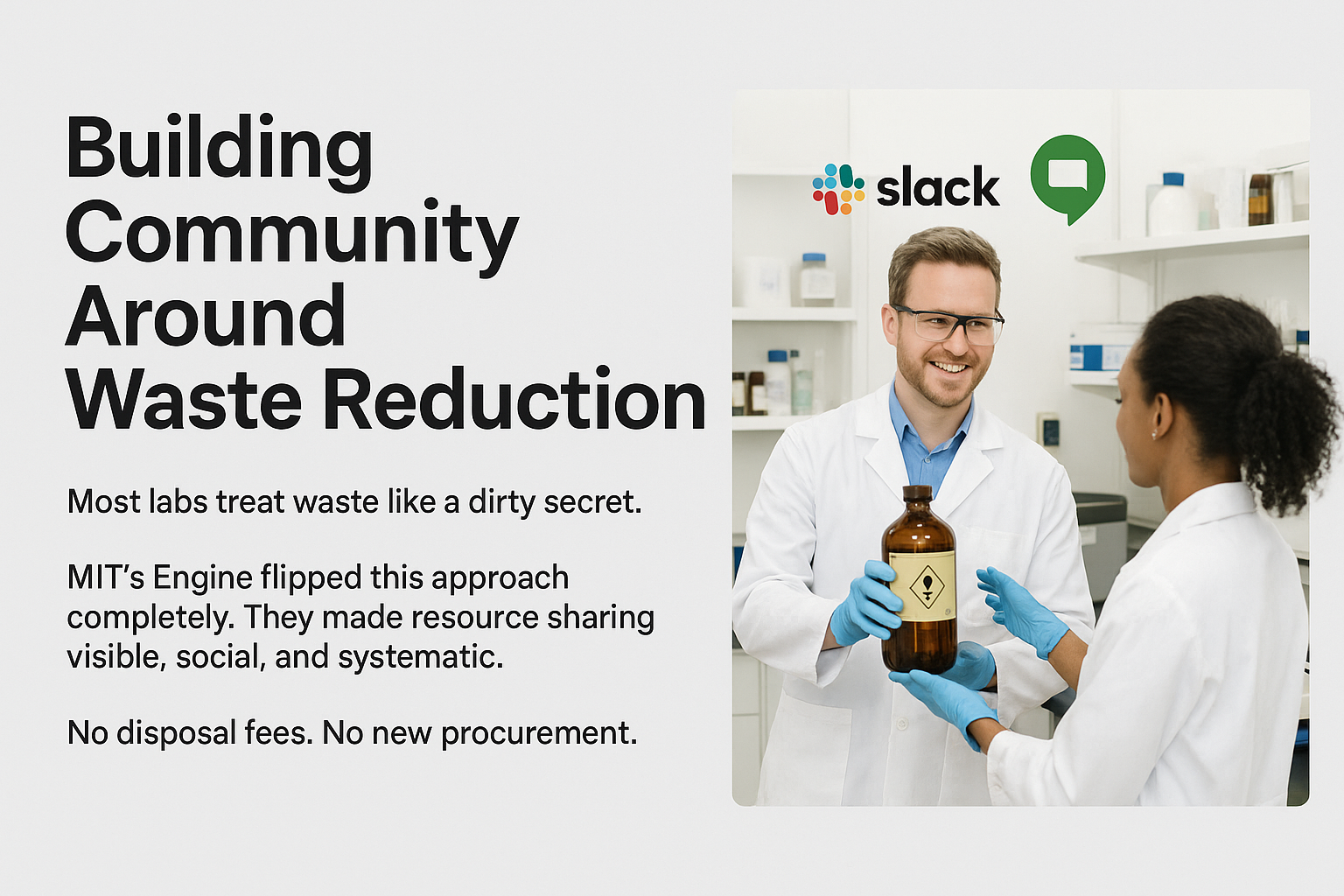The Procurement Mistake Costing Labs Thousands (And How to Fix It)
The Procurement Mistake Costing Labs Thousands (And How to Fix It)

The Procurement Mistake Costing Labs Thousands (And How to Fix It)
Why buying less might be the smartest investment your lab makes this year
Your lab just secured a major grant. Excited and eager to prepare, you stock up—cases of consumables, liters of solvents, boxes of reagents. Volume discounts look appealing, and you want to avoid running out mid-experiment.
Six months later, you're staring at shelves of expired reagents, a freezer packed with unused materials, and a depleted procurement budget. Now you're paying disposal fees for materials you paid to acquire.
Welcome to the bulk-buying trap. It's the most common procurement mistake labs make, according to Amanda, Lab Operations Manager at Innoventure Labs in Boston.
Her advice from years across veterinary clinics, cannabis testing, and biotech incubation? "Only buy as much as you need."
The True Cost of Overbuying
Overbuying creates a cascading financial drain:
Expiration Waste = Double Loss
- You lose the original purchase cost
- You pay disposal fees for unused materials
- For hazmat, disposal costs 3-5x more than the chemical itself
Storage Costs Add Up
- Lab space costs $50-100+ per square foot annually
- ULT freezers cost $500-800/year to operate
- Overcrowded storage reduces space for active experiments
Cash Flow Problems
- Money tied up in inventory instead of research
- Less flexibility to pivot or seize opportunities
- Strain on grant budgets
Productivity Tax
- Time wasted searching for materials
- Safety risks from cluttered workspaces
- Duplicative purchases from poor tracking
The Field Testing Rule: Buy Small
Steve from LabRenew is emphatic: "When you're just field testing a new process, that is not the time to buy up. That is the time to buy very, very small."
Why? During R&D:
- You don't know what will work yet
- Protocols change constantly
- Failed experiments happen
- Actual usage differs dramatically from estimates
The Smart Approach:
- Order minimum quantities only
- Buy for 2-4 weeks of experiments maximum
- Accept higher per-unit costs for flexibility
- Track actual consumption vs. estimates
- Scale up only after validation
Amanda saw this in cannabis testing: "We did batch samples, just optimizing things." Small-batch testing with right-sized procurement went hand-in-hand.
Lessons from Other Industries
Amanda's diverse background brings fresh procurement insights:
From Veterinary Medicine: Think Reusables
"We would use towels instead of disposable drapes, then wash them in energy-efficient machines. We used metal instrumentation we could autoclave."
The key: Calculate lifecycle cost, not just purchase price.
Lab applications:
- Glass vs. plastic labware (when chemistry allows)
- Reusable filter holders vs. disposable units
- Metal spatulas vs. disposable plastic
The Batching Principle
"Fill the autoclave all at once and do a good run, so we're not running and running it."
Apply this to:
- Batch orders to reduce shipping frequency
- Batch experiment prep to optimize materials
- Coordinate with neighboring labs for shared orders
From Cannabis Testing: Digital Tracking
"We did digital LIMS, which is a laboratory information management system."
Digital inventory systems provide:
- Real-time visibility of stock
- Automatic reorder alerts based on actual usage
- Prevention of duplicate orders
- Reduced expired materials
Even a simple shared spreadsheet beats mental tracking.
Right-Sizing by Research Stage
Your procurement strategy should evolve:
Stage 1: Field Testing
- Minimum quantities only
- 2-4 week supply maximum
- Higher per-unit cost acceptable
- Intensive usage tracking
Stage 2: Validation
- Order based on documented consumption
- 1-3 month supply for validated protocols
- 20% buffer for variation
- Establish reorder points
Stage 3: Production
- Just-in-time inventory
- Standing orders for predictable items
- Volume purchasing for validated needs
- Formal inventory management
The mistake? Using Stage 3 strategies during Stage 1, or never graduating when you should scale up.
Your 4-Week Procurement Fix
Week 1: Audit
- Photograph all storage areas
- List everything in stock with expiration dates
- Calculate dollar value of expired/expiring materials
- Review past 6 months of purchase orders
Week 2: Analyze
- Calculate actual usage rates for top 20 items
- Compare purchases to consumption
- Identify consistent overbuying patterns
- Calculate reorder points (usage × lead time + buffer)
Week 3: Create Rules
- Set maximum order quantities per item
- Establish approval process for bulk purchases
- Designate a procurement coordinator
- Set up tracking system (even a spreadsheet works)
Week 4: Implement
- Share new rules with entire team
- Explain the "why" with cost data
- Schedule monthly procurement reviews
- Celebrate early wins
When Bulk Buying Makes Sense
Strategic stockpiling is appropriate when:
- Long lead times (8-12 weeks) with uncertain supply
- Product discontinuation announced
- Grant requirements mandate specific purchase windows
- Significant volume discounts on stable, high-use items
- Seasonal research with predictable needs
Amanda acknowledges: "Obviously, have your backup for when you need it, but buying in smaller quantities definitely helps reduce things from expiring."
The difference is data-driven decision-making, not guesswork.
The Sustainability Bonus
Smart procurement reduces environmental impact. Every item you don't buy represents:
- Raw materials not extracted
- Manufacturing energy not consumed
- Packaging not created
- Transportation emissions not generated
- Disposal impacts not realized
"We guide to sustainable procurement methods, so that the businesses can really focus on the tech and what they're doing," Amanda explains.
Collaborative Procurement
At Innoventure Labs, the shared facility model promotes collaborative purchasing:
- Split bulk orders for volume pricing without excess
- Share specialty items used infrequently
- Coordinate deliveries to reduce packaging
- Pool knowledge about reliable suppliers
Even separate institutions can collaborate through shared spreadsheets, coordination calls, or messaging groups for real-time ordering coordination.
Measuring Success
Track these metrics monthly:
Financial:
- Total inventory value (should decrease)
- Expired inventory value (should approach zero)
- Disposal costs (should decrease)
Operational:
- Time from order to use (should decrease)
- Storage space utilization (should improve)
- Stockout incidents (should remain low)
Sustainability:
- Waste per experiment (should decrease)
- Packaging waste (should decrease)
The Bottom Line
Smart procurement requires no new equipment or major investment - just awareness, discipline, and simple systems.
The benefits:
- Better cash flow for opportunities
- Lower operating costs
- Increased productivity
- Environmental leadership
- More scientific focus
As Amanda demonstrates at Innoventure Labs, optimized procurement isn't a constraint it's an enabler. When you're not managing excess inventory, you focus energy on breakthrough research.
The question isn't whether you can afford to optimize procurement. It's whether you can afford not to.
Start Today
This Week:
- Audit one storage area
- Calculate expired materials value
- Identify your three most over-ordered items
This Month:
- Implement new rules for those three items
- Track consumption vs. estimates
- Calculate savings
This Quarter:
- Roll out system lab-wide
- Establish regular reviews
- Share your success
This article is based on our LinkedIn Live conversation - watch clips on our LinkedIn page.
.jpg)

